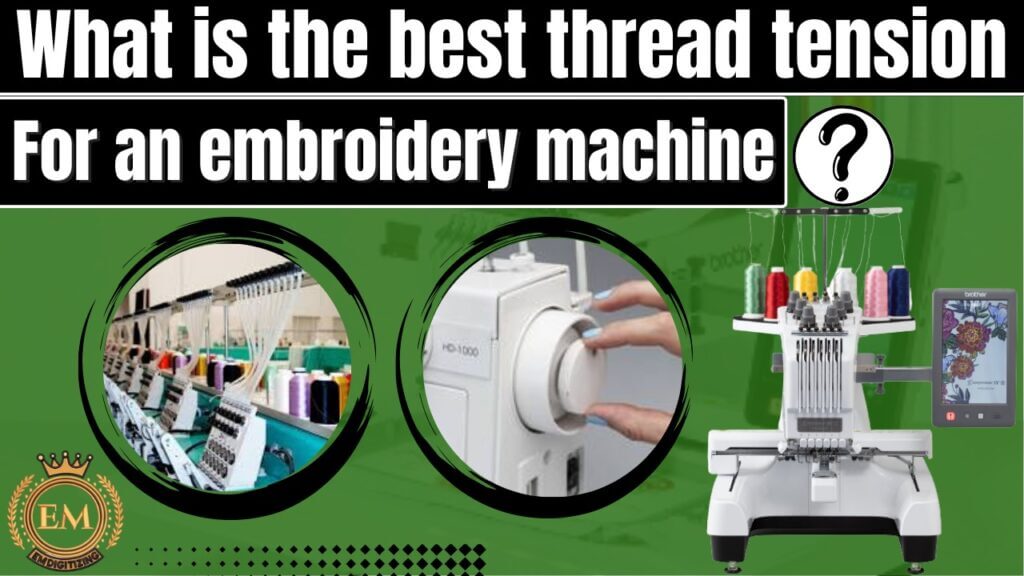Was ist die beste Fadenspannung für eine Stickmaschine?
Stickereispannung ist eines der frustrierendsten Themen in der Welt der Stickerei und das Lernen, fein ausgewogene Stickfadenspannungen anzupassen und aufrechtzuerhalten, ist eine Kunst, die perfektioniert werden muss.

Sobald Sie diese Fähigkeit entwickelt haben, wird dies einen großen Unterschied in Ihrer Produktion und der Qualität Ihrer fertigen Stickerei machen. Sehr oft Stickmotive sieht viel besser aus, wenn nur die Spannung auf der Maschine richtig eingestellt wird. Die falsche Spannung kann mehrere Probleme verursachen und ohne das grundlegende Know-how der Beziehung zwischen den oberen und unteren Threads, Es ist nicht möglich zu wissen, wie man sie korrigiert.
Es wird ein Stich gebildet, wenn die Nadel, die den oberen Faden trägt Unterfaden. Eine Schleife wird direkt hinter dem Auge der Nadel gebildet. Wenn die Nadel zurückkommt, wird sich der Faden verschärft, wenn Ihre Spannungen korrekt eingestellt werden. Wenn einer Ihrer Fäden zu eng ist, Die Chancen stehen gut, dass sie schnappen werden. Wenn sich an der Nadellochkante in der Nadelplatte ein Grat befindet, Als der Thread wieder hochkommt, Es könnte ausfransen oder sich teilen. Es ist wichtig, ein vollständiges Gleichgewicht zwischen Ihrem oberen und unteren Faden zu halten.
Was ist die richtige Stickspannung?

Das richtige Stickgarn Spannung ist ein Gleichgewicht zwischen zu eng und zu locker. Ideal, Der Faden sollte eng genug sein, um glatte und sogar Stiche zu erzeugen, aber nicht so eng, dass der Stoff den Kürze oder den Faden brechen lassen. Der empfohlene Ausgangspunkt zum Einstellen der Spannung ist normalerweise die mittlere Einstellung auf dem Spannungswahl oder der Schraube der Stickmaschine. Das Testen der Spannung auf einem Schrottstück vor dem Starten eines Projekts ist eine gute Möglichkeit, um die gewünschten Ergebnisse zu gewährleisten.
Hier sind einige typische Szenarien, in denen Ihre Stickereispannung angepasst werden muss:

- Fadenbruch: Wenn die Faden reißt häufig, Die Spannung ist wahrscheinlich zu eng. Lösen Sie die Spannungswahl oder die Schraube leicht, bis der Gewinde aufhört zu brechen.
- Gepuchter Stoff: Wenn die Stoff nach dem Nähen pucken, Die Spannung ist wahrscheinlich zu eng. Lösen Sie das Spannungsschalter oder die Schraube, bis der Stoff flach liegt.
- Lose Stiche: Wenn die Stiche sich locker aussehen und der Faden neigt, sich zu entwirren, Die Spannung ist wahrscheinlich zu locker. Ziehen Sie das Spannungsschalter oder die Schraube fest, bis die Stiche ordentlich und sicher sind.
- Änderung des Stofftyps oder des Gewichts: Verschiedene Arten von Stoff und unterschiedliche Gewichte können die Spannung beeinflussen. Beim Umschalten auf einen anderen Stofftyp, Passen Sie die Spannung entsprechend an, um die gewünschten Ergebnisse zu erzielen.
- Änderung des Fadentyps oder des Gewichts: Gleiches gilt für verschiedene Typen und Gewichte des Fadens. Beim Umschalten auf einen anderen Typ oder Gewicht von Faden, Passen Sie die Spannung an, die dem Thread entspricht.
- Maschinenwartung: Regelmäßige Reinigung und Ölen Ihrer Stickmaschine kann die Spannung beeinflussen. Überprüfen und passen Sie die Spannung nach Wartungsarbeiten an und passen Sie sie an.
Wenn Ihre Stickereispannungen nicht korrekt und ausgewogen sind, können Sie die folgenden Probleme haben:

- Schleifen: Wenn die Spannung zu locker ist, Der Faden kann oben oder unterhalb des Stoffes schleifen.
- Bruchfaden: Wenn die Spannung zu eng ist, Der Faden kann während des Nähens häufig brechen.
- Kräuseln: Wenn die Spannung zu eng ist, Der Stoff kann nach dem Nähen verzerrt werden.
- Übersprungene Stiche: Wenn die Spannung ungleichmäßig ist, Einige Stiche können enger oder lockerer sein als andere, ergebend Stiche übersprungen oder verpasste Stiche.
- Ungleichmäßige Stiche: Wenn die Spannung nicht ausgeglichen ist, Die Stiche können ungleichmäßig und unregelmäßig in Größe und Abstand erscheinen.
- Fadenverschmutzung: Wenn die Spannung zu locker ist, Der Faden kann sich an der Spule oder in der Maschine verwickeln, Unterbrechungen im Stitching -Prozess verursachen.
Inkonsistente Ergebnisse: Wenn die Spannung nicht richtig eingestellt ist, Die Ergebnisse können von einem Projekt zum nächsten inkonsistent sein, führt zu Frustration und Zeitverschwendung.
Einstellen der oberen Stickereispannung:

Um die obere Stickspannung anzupassen, folge diesen Schritten:
- Schalten Sie die Maschine aus und entfernen Sie den Reifen oder den Rahmen.
- Einen kleinen Schrott nehmen Stück Stoff und fädeln Sie es und laden Sie es auf die Maschine.
- Schalten Sie die Maschine ein und beobachten Sie den Stitching -Prozess. Beobachten Sie den oberen Faden und die Art und Weise, wie er mit dem Stoff und dem Spulenfaden interagiert.
- Wenn der obere Faden zu locker ist, Ziehen Sie das Spannungsschalter oder die Schraube an der Maschine fest, bis das obere Gewinde straff, aber nicht zu eng ist. Wenn der obere Faden zu eng ist, Lösen Sie das Spannungs -Zifferblatt oder die Schraube.
- Testen Sie die Spannung, indem Sie mehrere Linien auf dem Schrottstück Stoff nähen. Beobachten Sie die Stichqualität und passen Sie die Spannung nach Bedarf an.
- Wiederholen Sie diesen Vorgang, bis die obere Gewindespannung ausgeglichen ist und glatte und sogar Stiche erzeugt.
- Sobald die Spannung korrekt eingestellt ist, Stücken Sie ein Beispielprojekt, um die gewünschten Ergebnisse zu gewährleisten.
Bitte beachten Sie: Der genaue Vorgang zum Anpassen der oberen Gewindespannung kann je nach Typ und Modell Ihres Stickmaschine, Weitere Anweisungen finden Sie im Handbuch.
Überprüfen Sie Ihre Spannung, wenn Sie die Spulen ändern:

Es ist immer eine gute Idee, Ihre Spannung zu überprüfen, wenn Sie die Spulen ändern. Eine Änderung der Spulen kann die gesamte Fadenspannung beeinflussen, Da ist der Spulenfaden entscheidend für die Stichbildung. Hier sind die Schritte, um die Spannung zu überprüfen, wenn Sie die Spulen ändern:
- Schalten Sie die Maschine aus und entfernen Sie den Reifen oder den Rahmen.
- Ersetzen Sie die alte Spule durch einen neuen, Stellen Sie sicher, dass es richtig geladen ist und der Faden reibungslos durch die Spannungsfeder läuft.
- Schalten Sie die Maschine ein und beobachten Sie den Stitching -Prozess. Beobachten Sie den oberen Faden und die Art und Weise, wie er mit dem Stoff und dem Spulenfaden interagiert.
- Wenn der obere Faden zu locker oder zu eng erscheint, Stellen Sie das Spannungswahl oder die Schraube an der Maschine ein, bis das obere Gewinde ausgeglichen ist und glatte und sogar Stiche erzeugt.
- Testen Sie die Spannung, indem Sie mehrere Linien auf einem Schrottstück Stoff nähen. Beobachten Sie die Stichqualität und passen Sie die Spannung nach Bedarf an.
- Wiederholen Sie diesen Vorgang, bis die obere Gewindespannung ausgeglichen ist und konsistente Ergebnisse erzielt.
Überprüfen Sie Ihre Spannungspannung nach diesen Schritten:

Um die Spannspannung zu überprüfen, folge diesen Schritten:
- Schalten Sie die Maschine aus und entfernen Sie den Reifen oder den Rahmen.
- Entfernen Sie das Spulen aus dem Gehäuse und halten Sie es zwischen Daumen und Indexfinger., wobei der Faden herunter hängt.
- Ziehen.
- Die korrekte Spannspannung sollte es dem Faden mit einem leichten Widerstand aus dem Spulen ziehen lassen, Aber nicht so sehr, dass der Faden gespannt ist oder der Gehäuse des Spulenbbins von Ihren Fingern weggezogen wird.
- Wenn die Spannung zu locker ist, Ziehen Sie die Schraube am Spulenkoffer fest. Wenn die Spannung zu eng ist, Lösen Sie die Schraube.
- Wiederholen Sie den Vorgang des Überprüfens und Einstellens der Spannung, bis sich der Spulengewinde reibungslos aus dem Gehäuse zieht.
- Sobald die Spannspannung korrekt eingestellt ist, Ersetzen Sie die Spulen in der Maschine und testen Sie die Stichqualität auf einem Schrottstück Stoff.
Schlusszeile:
Wir hoffen, dass Sie jetzt die beste Fadenspannung für eine Stickmaschine verstehen. Wir hoffen, dass Ihnen das Lesen dieses Artikels genauso viel Spaß gemacht hat wie uns das Schreiben.
Wenn Sie die Digitalisierung des Sticklogos anpassen möchten, EM-DIGITALISIERUNG wird Ihre beste Wahl sein. Bei EM DIGITALISIEREN, Wir liefern das beste Sticklogo Digitalisierung Dienstleistungen mit bester Qualität. Wir bieten 50% Rabatt auf alle unsere Dienstleistungen für unsere potenziellen Kunden bei ihrer ersten Bestellung. So, Fordern Sie jetzt ein kostenloses Angebot an und wir werden uns mit Ihnen in Verbindung setzen.
Ich hoffe, dieser Artikel wird für euch hilfreich sein!
Wenn Sie Fragen zu diesem Artikel haben, können Sie uns gerne einen Kommentar hinterlassen. Und, danke fürs Lesen!
Um festzustellen, ob die Gewindespannung korrekt ist, Sie können die folgenden Tests durchführen:
–; Überprüfen Sie die Stichqualität: Die Stiche sollten reibungslos und sogar sein, ohne Schleifen oder Versammlungen auf der oberen oder unteren Seite des Stoffes.
–; Überprüfen Sie, ob Sie Puckering prüfen: Der Stoff sollte flach und glatt liegen, ohne sichtbare Klopfen oder Verzerrung.
–; Überprüfen Sie die Stichlänge: Die Stichlänge sollte konsistent und gleichmäßig sein, ohne übersprungene oder fehlende Stiche.
–; Prüfen Sie die Fadenspannung: Der Faden sollte straff, aber nicht zu eng oder zu locker sein, ohne Verwicklungen oder Fadenbruch.
Wenn eine dieser Bedingungen nicht erfüllt ist, Passen Sie die Gewindespannung an, bis die gewünschten Ergebnisse erzielt werden. Möglicherweise müssen Sie diesen Vorgang mehrmals wiederholen, um die korrekte Spannungseinstellung für Ihre spezifische Maschine und Ihren Fadenstyp zu finden.
Ja, Normalerweise erfordert dickerer Faden mehr Spannungen. Dickerer Faden hat mehr Gewicht und Masse, Dies kann dazu führen, dass es sich vom Stoff abzieht oder Schleifen auf der unteren Seite erzeugt. Wenn Sie die Spannung erhöhen.
Jedoch, Die genaue Menge an Spannung hängt von der Art des Stoffes ab, das Design, und die spezifische Maschine und der Gewinde werden verwendet. It’;S immer am besten, um die Spannung auf einem Schrottstück zu testen, bevor Sie Ihr endgültiges Projekt starten, um die richtige Einstellung für Ihre spezifischen Umstände zu ermitteln.
Es gibt mehrere Gründe, warum der untere Faden auf einer Stickmaschine locker sein kann:
–; Falsche Spannungspannung: Wenn die Spannspannung zu locker ist, Der untere Faden ist nicht eng genug, um sogar Stiche zu erzeugen.
–; Ungleichmäßige Platzierung von Fadenspulen: Wenn die Fadenspule nicht gleichmäßig auf den Spulennadel platziert ist, Es kann dazu führen, dass sich der Faden entwirft und lose Stiche erzeugt.
–; Falscher Threadpfad: Wenn der Fadenpfad nicht ordnungsgemäß durch die Maschine geführt wird, Es kann dazu führen, dass der Faden verwickelt oder geknickt wird, was zu losen Stichen führt.
–; Schlechte Fadenqualität: Wenn der Faden alt ist, beschädigt, oder von schlechter Qualität, Es kann wahrscheinlicher sein, dass es brechen oder gefragt, was zu losen Stichen führt.
–; Schmutzige Maschine: Eine schmutzige Maschine kann dazu führen, dass Faden verwickelt oder geknickt werden, was zu losen Stichen führt.
